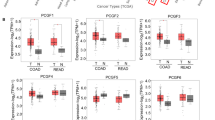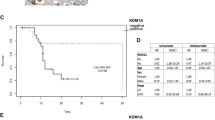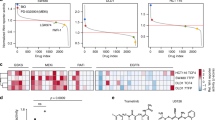Abstract
Epigenetic reprogramming has been associated with the functional plasticity of cancer-initiating cells (CICs); however, the regulatory pathway has yet to be elucidated. A siRNA screen targeting known epigenetic genes revealed that G9a profoundly impairs the chemo-resistance, self-renewal and metastasis of CICs obtained from patients with colorectal cancer (CRC). Patients with elevated G9a were shown to face a high risk of relapse and poor survival rates. From a mechanistic perspective, G9a binds with and stabilizes RelB, thereby recruiting DNA methyltransferase 3 on the Let-7b promoter and repressing its expression. This leads to the activation of the K-RAS/β-catenin pathway and regulates self-renewal and function of CICs. These findings indicate that the G9a/RelB/Let-7b axis acts as a critical regulator in the maintenance of CIC phenotypes and is strongly associated with negative clinical outcomes. Thus, these findings may have diagnostic as well as therapeutic implications for the treatment of chemotherapy-resistant or metastatic CRC.
This is a preview of subscription content, access via your institution
Access options
Subscribe to this journal
Receive 12 print issues and online access
$209.00 per year
only $17.42 per issue
Buy this article
- Purchase on Springer Link
- Instant access to full article PDF
Prices may be subject to local taxes which are calculated during checkout








Similar content being viewed by others
Change history
21 November 2016
In this Article, we reported that G9a promotes colorectal-cancer-initiating cell self-renewal and function by repressing Let-7b expression in a manner independent of its enzymatic activity, thereby activating K-RAS and β-catenin signalling. However, it has come to our attention that during figure assembly certain images were inappropriately processed and duplicated in several figures of the article, including Figs 1d, 2d, 3b, 5a, 5f, 6h and 8f. In light of these errors and image reuse in multiple figures we have no confidence in the accuracy of the reported data, and the conclusions of the paper may be affected. Therefore, we wish to retract the paper. We deeply regret these circumstances and apologize to the scientific community.
References
Di Franco, S., Todaro, M., Dieli, F. & Stassi, G. Colorectal cancer defeating? Challenge accepted! Mol. Aspects Med. 39, 61–81 (2013).
Siegel, R., Naishadham, D. & Jemal, A. Cancer statistics, 2013. CA Cancer J. Clin. 63, 11–30 (2013).
Markowitz, S. D. & Bertagnolli, M. M. Molecular basis of colorectal cancer. N. Engl. J. Med. 361, 2449–2460 (2009).
Li, L., Cole, J. & Margolin, D. A. Cancer stem cell and stromal microenvironment. Ochsner J. 13, 109–118 (2013).
O’Brien, C. A., Pollett, A., Gallinger, S. & Dick, J. E. A human colon cancer cell capable of initiating tumour growth in immunodeficient mice. Nature 445, 106–110 (2006).
Abdul Khalek, F. J., Gallicano, G. I. & Mishra, L. Colon cancer stem cells. Gastrointest. Cancer Res. Suppl 1, S16–S23 (2010).
O’Brien, C. A. et al. ID1 and ID3 regulate the self-renewal capacity of human colon cancer-initiating cells through p21. Cancer Cell 21, 777–792 (2012).
Crea, F., Danesi, R. & Farrar, W. L. Cancer stem cell epigenetics and chemoresistance. Epigenomics 1, 63–79 (2009).
Todaro, M. et al. Colon cancer stem cells dictate tumor growth and resist cell death by production of Interleukin-4. Cell Stem Cell 1, 389–402 (2007).
He, X. C. et al. BMP signaling inhibits intestinal stem cell self-renewal through suppression of Wnt–β-catenin signaling. Nat. Genet. 36, 1117–1121 (2004).
Marusyk, A. & Polyak, K. Cancer cell phenotypes, in fifty shades of grey. Science 339, 528–529 (2013).
Ying, Y. & Tao, Q. Epigenetic disruption of the WNT/β-catenin signaling pathway in human cancers. Epigenetics 4, 307–312 (2009).
Vermeulen, L. et al. Wnt activity defines colon cancer stem cells and is regulated by the microenvironment. Nat. Cell Biol. 12, 468–476 (2010).
Lao, V. V. & Grady, W. M. Epigenetics and colorectal cancer. Nat. Rev. Gastroenterol. Hepatol. 8, 686–700 (2011).
Kanwal, R. & Gupta, S. Epigenetic modifications in cancer. Clin. Genet. 81, 303–311 (2011).
Kreso, A. et al. Self-renewal as a therapeutic target in human colorectal cancer. Nat. Med. 20, 29–36 (2014).
Dow, L. E. et al. Apc restoration promotes cellular differentiation and reestablishes crypt homeostasis in colorectal cancer. Cell 161, 1539–1552 (2015).
You, J. S. & Jones, P. A. Cancer genetics and epigenetics: two sides of the same coin? Cancer Cell 22, 9–20 (2012).
Cantone, I. & Fisher, A. G. Epigenetic programming and reprogramming during development. Nat. Struct. Mol. Biol. 20, 282–289 (2013).
Hu, G. et al. A genome-wide RNAi screen identifies a new transcriptional module required for self-renewal. Genes Dev. 23, 837–848 (2009).
David, R. Development: G9A covers all bases. Nat. Rev. Mol. Cell Biol. 14, 5 (2012).
Shankar, S. R. et al. G9a, a multipotent regulator of gene expression. Epigenetics 8, 16–22 (2013).
Li, B. et al. G9a co-localized with histone H3 lysine 9 monomethylation but not dimethylation in a nuclear membrane-dependent manner during mouse preimplantation embryo development. J. Assist. Reprod. Genet. 30, 441–448 (2012).
Tachibana, M. et al. G9a histone methyltransferase plays a dominant role in euchromatic histone H3 lysine 9 methylation and is essential for early embryogenesis. Gene Dev. 16, 1779–1791 (2002).
Easwaran, H., Tsai, H.-C. & Baylin, S. B. Cancer epigenetics: tumor heterogeneity, plasticity of stem-like states, and drug resistance. Mol. Cell 54, 716–727 (2014).
Kobayashi, S. et al. LGR5-positive colon cancer stem cells interconvert with drug-resistant LGR5-negative cells and are capable of tumor reconstitution. Stem Cells 30, 2631–2644 (2012).
Westphalen, C. B. et al. Long-lived intestinal tuft cells serve as colon cancer-initiating cells. J. Clin. Invest. 124, 1283–1295 (2014).
Kreso, A. et al. Self-renewal as a therapeutic target in human colorectal cancer. Nat. Med. 20, 29–36 (2014).
Yi, S.-Y., Hao, Y.-B., Nan, K.-J. & Fan, T.-L. Cancer stem cells niche: a target for novel cancer therapeutics. Cancer Treat. Rev. 39, 290–296 (2013).
Yang, W.-H. et al. RAC1 activation mediates Twist1-induced cancer cell migration. Nat. Cell Biol. 14, 366–374 (2012).
Muñoz, P., Iliou, M. S. & Esteller, M. Epigenetic alterations involved in cancer stem cell reprogramming. Mol. Oncol. 6, 620–636 (2012).
Gemei, M. et al. CD66c is a novel marker for colorectal cancer stem cell isolation, and its silencing halts tumor growth in vivo. Cancer 119, 729–738 (2013).
Pang, R. et al. A subpopulation of CD26 + cancer stem cells with metastatic capacity in human colorectal cancer. Cell Stem Cell 6, 603–615 (2010).
Chu, C.-Y. et al. Stromal cell-derived factor-1α (SDF-1alpha/CXCL12)-enhanced angiogenesis of human basal cell carcinoma cells involves ERK1/2-NF-κB/interleukin-6 pathway. Carcinogenesis 30, 205–213 (2009).
Korinek, V. et al. Constitutive Transcriptional Activation by a β-Catenin–Tcf Complexin APC. Science 275, 1784–1787 (1997).
Kumar, A. et al. Chemopreventive sphingadienes downregulate Wnt signaling via a PP2A/Akt/GSK3 pathway in colon cancer. Carcinogenesis 33, 1726–1735 (2012).
Dembinski, J. L. & Krauss, S. Characterization and functional analysis of a slow cycling stem cell-like subpopulation in pancreas adenocarcinoma. Clin. Exp. Metastasis 26, 611–623 (2009).
Moon, B.-S. et al. Role of oncogenic K-Ras in cancer stem cell activation by aberrant Wnt/β-catenin signaling. J. Natl. Cancer Inst. 106, djt373 (2014).
Li, K.-C. et al. Inhibition of G9a induces DUSP4-dependent autophagic cell death in head and neck squamous cell carcinoma. Mol. Cancer 13, 172–186 (2014).
Tao, H. et al. Histone methyltransferase G9a and H3K9 dimethylation inhibit the self-renewal of glioma cancer stem cells. Mol. Cell. Biochem. 394, 23–30 (2014).
Bhola, N. E. et al. Treatment of triple-negative breast cancer with TORC1/2 inhibitors sustains a drug-resistant and notch-dependent cancer stem cell population. Cancer Res. 76, 440–452 (2016).
Karamboulas, C. & Ailles, L. Developmental signaling pathways in cancer stem cells of solid tumors. Biochim. Biophys. Acta 1830, 2481–2495 (2013).
Morin, P. J. et al. Activation of beta-catenin-Tcf signaling in colon cancer by mutations in beta-catenin or APC. Science 275, 1787–1790 (1997).
Nava, P. et al. IFN-induced suppression of β-catenin signaling: evidence for roles of Akt and 14.3.3. Mol. Biol. Cell 25, 2894–2904 (2014).
Roesch, A. et al. A temporarily distinct subpopulation of slow-cycling melanoma cells is required for continuous tumor growth. Cell 141, 583–594 (2010).
Ko, S. Y., Dass, C. R. & Nurgali, K. Netrin-1 in the developing enteric nervous system and colorectal cancer. Trends Mol. Med. 18, 544–554 (2012).
Bu, P. et al. A microRNA miR-34a-regulated bimodal switch targets notch in colon cancer stem cells. Cell Stem Cell 12, 602–615 (2013).
Hwang, W.-L. et al. MicroRNA-146a directs the symmetric division of Snail-dominant colorectal cancer stem cells. Nat. Cell Biol. 16, 268–280 (2014).
Chen, P.-S. et al. miR-107 promotes tumor progression by targeting the let-7 microRNA in mice and humans. J. Clin. Invest. 121, 3442–3455 (2011).
Kala, R., Peek, G. W., Hardy, T. M. & Tollefsbol, T. O. MicroRNAs: an emerging science in cancer epigenetics. J. Clin. Bioinformatics 3, 6–14 (2013).
Chen, M.-W. et al. H3K9 histone methyltransferase G9a promotes lung cancer invasion and metastasis by silencing the cell adhesion molecule Ep-CAM. Cancer Res. 70, 7830–7840 (2010).
Dong, C. et al. Loss of FBP1 by snail-mediated repression provides metabolic advantages in basal-like breast cancer. Cancer Cell 23, 316–331 (2013).
Hua, K.-T. et al. The H3K9 methyltransferase G9a is a marker of aggressive ovarian cancer that promotes peritoneal metastasis. Mol. Cancer 13, 189–202 (2014).
Tachibana, M. SET domain-containing protein, G9a, is a novel lysine-preferring mammalian histone methyltransferase with hyperactivity and specific selectivity to lysines 9 and 27 of histone H3. J. Biol. Chem. 276, 25309–25317 (2001).
Caamaño, J., Alexander, J., Craig, L., Bravo, R. & Hunter, C. A. The NF-κB family member RelB is required for innate and adaptive immunity to Toxoplasma gondii. J. Immunol. 163, 4453–4461 (1999).
Pettit, A. R. et al. Nuclear localization of RelB is associated with effective antigen-presenting cell function. Immunology 163, 4453–4461 (1997).
Shinkai, Y. & Tachibana, M. H3K9 methyltransferase G9a and the related molecule GLP. Genes Dev. 25, 781–788 (2011).
Liu, F. et al. Discovery of a 2,4-diamino-7-aminoalkoxyquinazoline as a potent and selective inhibitor of histone lysine methyltransferase G9a. J. Med. Chem. 52, 7950–7953 (2009).
Smith, J. J. et al. Experimentally derived metastasis gene expression profile predicts recurrence and death in patients with colon cancer. Gastroenterology 138, 958–968 (2010).
Acknowledgements
We thank C.-S. Chen (Institute of Biological Chemistry, Academia Sinica, Taipei, Taiwan) for the gift of K-RASG12D and K-RASG12V plasmid. We also thank the Technology Commons in the College of Life Science and Center for Systems Biology, National Taiwan University, for instrument support for cell sorting. This work was supported by grants from the National Science Council, Taiwan (NSC 099-2811-C-099-003; NSC 100-2811-C-099-003; NSC 102-2321-B-002-034), the Ministry of Science and Technology, Taiwan (MOST 104-231-B-002-006; MOST 104-2320-B-002-070-MY3; MOST 104-2911-I-002-302); and National Taiwan University (NTU 104-R7559-6; NTU 104R8952-1; NTU 104R7602).
Author information
Authors and Affiliations
Contributions
S.-T.C. and M.-L.K. conceived and designed the experiments. S.-T.C. analysed the data with the assistance of C.-T.T. and B.-Z.L. for the clinical data analysis. S.-T.C., M.-L.K. and C.-C.C. wrote the paper with assistance from C.-Y.C. W.-J.L. designed and carried out in vivo work and a portion of the plasmid construction. The sample collection and treatment of CRC patients were performed by B.-Z.L. M.-T.L. carried out the sample collection and supervised this work. M.-L.K. designed and supervised this work.
Corresponding authors
Ethics declarations
Competing interests
The authors declare no competing financial interests.
Integrated supplementary information
Supplementary Figure 1 Validation of the stem-like and differentiation properties in LGR5-RFP+ and CK20-GFP+ cells.
(a) RT-qPCR for the stemness gene (left panel) and differentiation gene (right panel) in LGR5-RFP+ and CK20-GFP+cells. Data represent mean ± S. D. n = 3 independent experiment (each experiment contains 3 technical replicates). (b) Sphroid formation (left panel) and TOP/FOP reporter activity (right panel) in LGR5-RFP+ and CK20-GFP+cells. Data represent mean ± S. D. n = 3 independent experiment (each experiment contains 3 technical replicates). (c) RT-qPCR to illustrated the mRNA levels of knockdown efficacy of 19 epigenetic regulators. Data represent mean ± S. D. n = 3 independent experiment (each experiment contains 3 technical replicates).
Supplementary Figure 2 G9a activate AKT signalling and β-catenin phosphorylation in K-RAS mutant CCICs.
(a) Western blotting analysis of indicated antibody in CCICs versus non-CCICs in APC wt and mutated CRC cells. (b) Let-7b expression in (a). n = 3 for each group; P < 0.01 by Student’s t-test. (c) Upper: Western blot analysis of p-AKT, AKT, p- β-catenin and β-catenin in K-RAS wildtype and mutated CRC cells treatment with different dosage of specific PI3K inhibitor, XL147. Lower: TOP/FOP activity assay. Data represent mean ± S. D. n = 3 independent experiment (each experiment contains 3 technical replicates). (d) Western blot analysis of p-AKT, AKT, p- β-catenin and β-catenin in K-RAS wildtype and mutated CRC cells transient transfection with shAKT plasmid. Lower: TOP/FOP activity assay. Data represent mean ± S. D. n = 3 independent experiment (each experiment contains 3 technical replicates). (e) RT-qPCR of K-RAS expreesion in CD133− and CD133+ cells. Uncropped images of blots of a, c, d, are shown in Supplementary Fig. 6.
Supplementary Figure 3 ChIP-Seq analysis.
(a) Chip-Seq peaks over chromosomes. (b) Overlap between the top 20,000 genomic location (1-kb windown) bounds by G9a, H3K9me2 and shG9a-reexpressed DNG9a as determined using Illumina. GEO accession number: GSE82131.
Supplementary Figure 4 GLP, the obligatory G9a partner, plays as a bridge to stabilize G9a protein in functional roles in CCICs.
(a) Upper: Western blot analysis of G9a, GLP, H3K9me2 and RelB in CCICs transient transfection with shG9a, shGLP, G9a or DNG9a. Lower: sphere formation analysis. n = 3 independent experiments (each experiment contains 5 technical replicates). (b) Upper: Western blot analysis of G9a, GLP, H3K9me2 and RelB in CCICs transient transfection with shGLP, G9a and DNG9a. Lower: sphere formation analysis. n = 3 independent experiments (each experiment contains 5 technical replicates). (c) Western blot analysis of G9a, GLP, H3K9me2, RelB, K-RAS, p-β-catenin and β-catenin in CCICs transfection with shG9a GLP expression plasmid. (d) RT-qPCR for Let-7b expression in (c). n = 3 independent experiment (each experiment contains 3 technical replicates). (e) TOP/FOP activity assay in (c). Data represent mean ± s.d.n = 3 independent experiment (each experiment contains 3 technical replicates). (f) Sphere formation analysis in (c). n = 3 (each experiment contains 5 technical replicates). (g) Uncropped images of blots of a–c are shown in Supplementary Fig. 6.
Supplementary Figure 5 Two shRNA sequence to target G9a and GLP to avoid off-target effects.
(a) Western blot analysis of G9a, GLP, H3K9me2, RelB, KRAS, p-β-catenin and β-catenin in CCICs transfection with two different sequence of shG9a and shGLP plasmid in CCICs. (b) RT-qPCR for Let-7b expression in (a). n = 3 independent experiment (each experiment contains 3 technical replicates). (c) TOP/FOP activity assay in (a). Data represent mean ± S. D. n = 3 independent experiment (each experiment contains 3 technical replicates). (d) Sphere formation in (a) n = 3 (each experiment contains 5 technical replicates). (e) Representative image of immunohistochemical staining for G9a, RelB and K-RAS. Scale bars, 200 μm. (g) G9a-RelB-Let-7b-K-RAS-β-catenin signalling in CCICs.
Supplementary information
Supplementary Information
Supplementary Information (PDF 16199 kb)
Supplementary Table 1
Supplementary Information (XLSX 67 kb)
Supplementary Table 2
Supplementary Information (XLSX 73 kb)
Supplementary Table 3
Supplementary Information (XLSX 33 kb)
Supplementary Table 4
Supplementary Information (XLSX 42 kb)
Supplementary Table 5
Supplementary Information (XLSX 45 kb)
Supplementary Table 6
Supplementary Information (XLS 55 kb)
Supplementary Table 7
Supplementary Information (XLS 35 kb)
Supplementary Table 8
Supplementary Information (XLSX 86 kb)
Rights and permissions
About this article
Cite this article
Cha, ST., Tan, CT., Chang, CC. et al. G9a/RelB regulates self-renewal and function of colon-cancer-initiating cells by silencing Let-7b and activating the K-RAS/β-catenin pathway. Nat Cell Biol 18, 993–1005 (2016). https://doi.org/10.1038/ncb3395
Received:
Accepted:
Published:
Issue Date:
DOI: https://doi.org/10.1038/ncb3395
This article is cited by
-
A biomechanical view of epigenetic tumor regulation
Journal of Biological Physics (2023)
-
Inhibition of histone methyltransferase G9a attenuates liver cancer initiation by sensitizing DNA-damaged hepatocytes to p53-induced apoptosis
Cell Death & Disease (2021)
-
Expression of G9a in Auditory Cortex Is Downregulated in a Rat Model of Age-Related Hearing Loss
Journal of Molecular Neuroscience (2021)
-
WDR76 degrades RAS and suppresses cancer stem cell activation in colorectal cancer
Cell Communication and Signaling (2019)
-
RelB intrinsically regulates the development and function of medullary thymic epithelial cells
Science China Life Sciences (2018)



